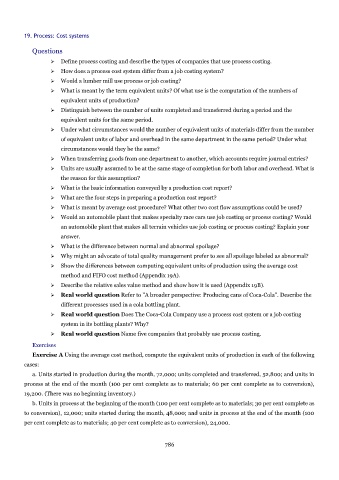Page 785 - Accounting Principles (A Business Perspective)
P. 785
19. Process: Cost systems
Questions
➢ Define process costing and describe the types of companies that use process costing.
➢ How does a process cost system differ from a job costing system?
➢ Would a lumber mill use process or job costing?
➢ What is meant by the term equivalent units? Of what use is the computation of the numbers of
equivalent units of production?
➢ Distinguish between the number of units completed and transferred during a period and the
equivalent units for the same period.
➢ Under what circumstances would the number of equivalent units of materials differ from the number
of equivalent units of labor and overhead in the same department in the same period? Under what
circumstances would they be the same?
➢ When transferring goods from one department to another, which accounts require journal entries?
➢ Units are usually assumed to be at the same stage of completion for both labor and overhead. What is
the reason for this assumption?
➢ What is the basic information conveyed by a production cost report?
➢ What are the four steps in preparing a production cost report?
➢ What is meant by average cost procedure? What other two cost flow assumptions could be used?
➢ Would an automobile plant that makes specialty race cars use job costing or process costing? Would
an automobile plant that makes all terrain vehicles use job costing or process costing? Explain your
answer.
➢ What is the difference between normal and abnormal spoilage?
➢ Why might an advocate of total quality management prefer to see all spoilage labeled as abnormal?
➢ Show the differences between computing equivalent units of production using the average cost
method and FIFO cost method (Appendix 19A).
➢ Describe the relative sales value method and show how it is used (Appendix 19B).
➢ Real world question Refer to "A broader perspective: Producing cans of Coca-Cola". Describe the
different processes used in a cola bottling plant.
➢ Real world question Does The Coca-Cola Company use a process cost system or a job costing
system in its bottling plants? Why?
➢ Real world question Name five companies that probably use process costing.
Exercises
Exercise A Using the average cost method, compute the equivalent units of production in each of the following
cases:
a. Units started in production during the month, 72,000; units completed and transferred, 52,800; and units in
process at the end of the month (100 per cent complete as to materials; 60 per cent complete as to conversion),
19,200. (There was no beginning inventory.)
b. Units in process at the beginning of the month (100 per cent complete as to materials; 30 per cent complete as
to conversion), 12,000; units started during the month, 48,000; and units in process at the end of the month (100
per cent complete as to materials; 40 per cent complete as to conversion), 24,000.
786

